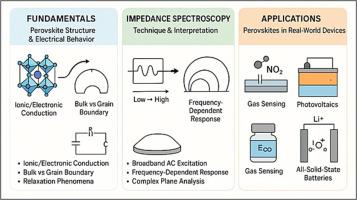钙钛矿材料中的阻抗谱:从基础到应用
IF 5.4
3区 化学
Q1 CHEMISTRY, INORGANIC & NUCLEAR
引用次数: 0
摘要
钙钛矿材料由于其丰富的结构灵活性和多种输运性质,在能量转换、存储、传感和电子器件中具有广泛的应用前景。阻抗谱(IS)已经成为探测这些材料复杂电学行为不可或缺的工具,能够在宽频率范围内解开体、晶界和电极相关过程的纠缠。本文综述了阻抗谱在钙钛矿系统中的应用,从阻抗谱的基本原理和等效电路建模开始,然后深入讨论了弛豫现象、缺陷化学和电荷输运机制。特别强调的是在理解混合离子-电子传导,介电行为和电化学界面在无机和杂化有机-无机钙钛矿的最新进展。这篇综述探讨了包括固态电池、燃料电池、传感器和光伏器件在内的关键应用,重点介绍了阻抗分析如何指导材料设计和器件优化。讨论了阻抗谱的基本方面,关键的测量技术和结果的解释。此外,该综述强调了使用IS优化制造工艺和增强钙钛矿器件长期稳定性的最新进展。最后,讨论了歌剧信息系统、多维分析和数据驱动建模方面的挑战和新兴趋势,概述了该领域的未来方向。这项工作旨在将基本见解与实际实施联系起来,为从事钙钛矿技术开发和应用的研究人员提供宝贵的资源。本文章由计算机程序翻译,如有差异,请以英文原文为准。

Impedance spectroscopy in perovskite materials: From fundamentals to applications
Perovskite materials have emerged as a versatile class of compounds with broad applicability in energy conversion, storage, sensing, and electronic devices, owing to their rich structural flexibility and diverse transport properties. Impedance spectroscopy (IS) has become an indispensable tool for probing the complex electrical behaviour of these materials, enabling the disentanglement of bulk, grain boundary, and electrode-related processes across a wide frequency range. This review provides a comprehensive overview of impedance spectroscopy as applied to perovskite systems, beginning with the fundamental principles of IS and equivalent circuit modelling, followed by an in-depth discussion of relaxation phenomena, defect chemistry, and charge transport mechanisms. Particular emphasis is placed on recent advances in understanding mixed ionic-electronic conduction, dielectric behaviour, and electrochemical interfaces in both inorganic and hybrid organic–inorganic perovskites. The review explores key applications including solid-state batteries, fuel cells, sensors, and photovoltaic devices, highlighting how impedance analysis informs material design and device optimization. The fundamental aspects of impedance spectroscopy, the key measurement techniques, and the interpretation of results are discussed. Furthermore, the review highlights recent advancements in using IS to optimize the fabrication processes and enhance the long-term stability of perovskite devices. Finally, challenges and emerging trends in operando IS, multi-dimensional analysis, and data-driven modelling are discussed, outlining future directions for the field. This work aims to bridge fundamental insights with practical implementation, providing a valuable resource for researchers engaged in the development and application of perovskite-based technologies.
求助全文
通过发布文献求助,成功后即可免费获取论文全文。
去求助
来源期刊

Inorganic Chemistry Communications
化学-无机化学与核化学
CiteScore
5.50
自引率
7.90%
发文量
1013
审稿时长
53 days
期刊介绍:
Launched in January 1998, Inorganic Chemistry Communications is an international journal dedicated to the rapid publication of short communications in the major areas of inorganic, organometallic and supramolecular chemistry. Topics include synthetic and reaction chemistry, kinetics and mechanisms of reactions, bioinorganic chemistry, photochemistry and the use of metal and organometallic compounds in stoichiometric and catalytic synthesis or organic compounds.
 求助内容:
求助内容: 应助结果提醒方式:
应助结果提醒方式:


